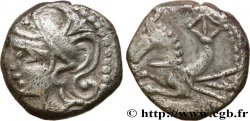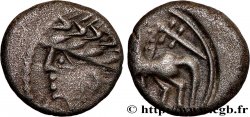v36_1265 - GALLIA - ALLOBROGES (Region di Dauphine) Denier au cheval galopant et au “caducée”
MONNAIES 36 (2008)
Начальная цена : 240.00 €
Назначить цену : 350.00 €
Цена реализации : 240.00 €
Начальная цена : 240.00 €
Назначить цену : 350.00 €
Цена реализации : 240.00 €
Тип Denier au cheval galopant et au “caducée”
Дата: Ier siècle avant J.-C.
Металл: silver
Диаметр: 13 mm
Ориентация осей монеты: 12 h.
Вес: 2,25 g.
Редкость: R1
Комментарии о состоянии
Flan régulier, mais un peu court. Le droit et le revers sont parfaitement centrés. Patine grise de collection ancienne
Ссылки в каталоге: :
Происхождение:
Cet exemplaire provient de la collection d’Antonin Deroc ; c’est celui qui illustre son ouvrage “Les monnaies d’argent de la vallée du Rhône”, n° 129
Лицевая сторона
Аверс: легенда: ANÉPIGRAPHE.
Аверс: описание: Tête laurée à gauche.
Обратная сторона
Реверс: легенда: ANÉPIGRAPHE.
Реверс: Описание: Cheval galopant à gauche ; au-dessus, “caducée”.
Комментарий
Bien que la distinction semble parfois subjective, ce denier semble s’approcher des monnaies du Groupe B “au profil stylisé” du Nouvel Atlas.








 Cообщить об ошибке
Cообщить об ошибке Распечатать страницу
Распечатать страницу Отправить мой выбор
Отправить мой выбор Задать вопрос
Задать вопрос Consign / sell
Consign / sell
 Информация
Информация








